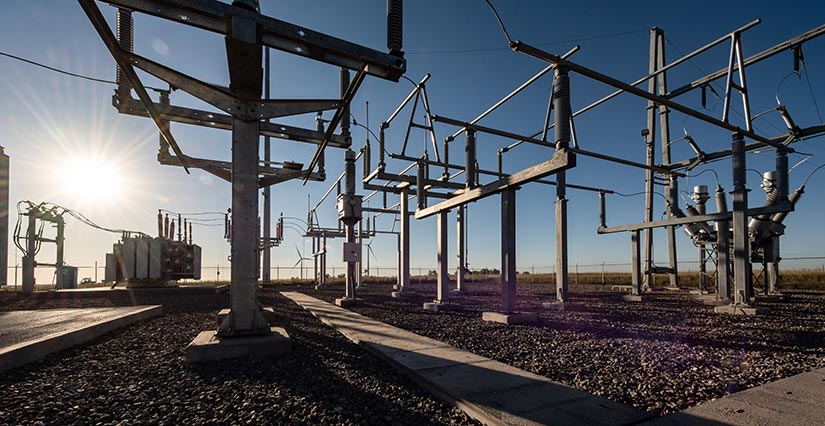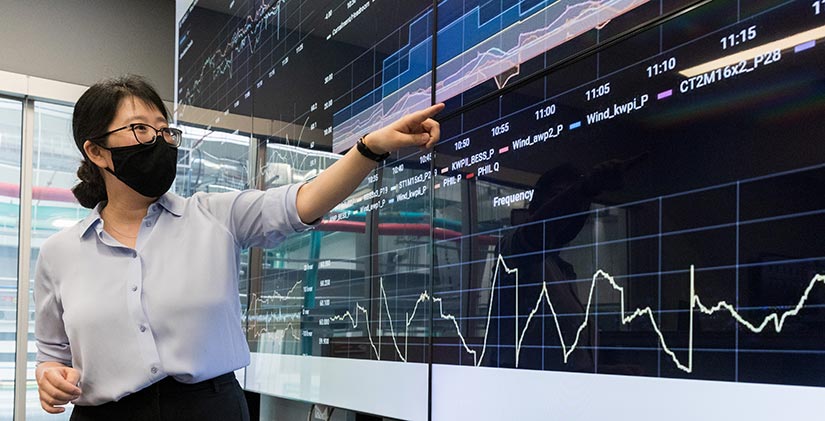NREL Builds Out National Capability To De-Risk Big Changes in Grid Infrastructure
The Power Electronic Grid Interface (PEGI) Platform at NREL Will Move Power Grid Innovations Rapidly From Prototype to the Field

As the electrical grid makes a historic transition to renewable and distributed energy, even its organizing principles are in flux. Incoming power electronics, like the inverters that interconnect solar panels and battery systems with the grid, could cause a wholescale shift in grid technology from electro-mechanical to electronic, and from rigid physics to programmability. This transition requires a deep look at how to develop, control, and deploy upcoming power electronic devices for energy systems, which is now possible with the Power Electronic Grid Interface (PEGI) platform at the National Renewable Energy Laboratory (NREL).
PEGI is part of NREL's Advanced Research on Integrated Energy Systems (ARIES) platform, the nation's primary research site to prove advanced energy system concepts. ARIES makes it possible to combine research platforms for an almost-limitless scope, allowing PEGI to explore the diverse grid impacts of power electronics, including everything from consumer electronics like modern refrigerators and electric vehicles, to inverter-based resources like wind, solar photovoltaics, and battery systems, and the next generation of grid technologies that are revolutionizing medium- and low-voltage power systems.

"We are seeing a wave of power electronic devices interconnecting at all levels of the electric grid, and we have no precedent that can inform us about how exactly to proceed," said Barry Mather, manager of integrated devices and systems research at NREL. "This is a critical moment for the industry and grid planners to understand the technologies shaping their systems and find solutions to their specific needs. PEGI is foremost an asset for partners to experiment in a realistic and risk-free environment."
Plug and Play at Megawatt Scale
One defining aspect of PEGI is the freedom to model grid scenarios at the megawatt scale. PEGI is specifically focused on addressing grid stability questions such as grid-forming inverter control, operating the grid with high amounts of inverter-based resources, and the interconnection of wind and solar plants.
PEGI has a dedicated power system: As power is wired into NREL's campuses from the local utility, it first passes through a controllable grid interface that allows researchers to customize power conditions. At this interface, researchers can invent grid scenarios: A fault, a blackout, or a 100% renewable energy system, for example. Down-line from the grid interface, PEGI equipment then evaluates the responses and control interactions of power electronic devices under-test.

PEGI provides users with a power systems sandbox to play-out device operations for any power technology, under any scenario, or with any system design. It offers a highly realistic environment to de-risk future technology and its effects on grid stability, interactions with other devices, and overall performance. PEGI can transport technologies decades into the future by bringing not-yet existent grid configurations to life in the safety of the lab.
“The special role of PEGI is to show very precisely how a system would operate under future scenarios, and future mixes of renewable and conventional resources.”
Core PEGI Assets
- A 2-MVA PV inverter to represent inverter-based resources and rapidly prototype controls
- A dynamometer-driven 2-MVA synchronous machine to represent conventional generation and operate as a synchronous condenser
- A medium-voltage impedance network to reproduce fast-timescale dynamics of power systems
- Connection to digital real-time simulation capabilities for advanced power hardware-in-the-loop experiments.
- Connection to megawatts of diverse distributed energy resources: Multiple energy storage technologies, electric vehicles and chargers, electrolyzers, and more
- A dedicated pad for partner equipment to be installed and interfaced with the PEGI platform.
Besides drop-in technology validations, PEGI is a unique space for addressing one of the stickiest issues of renewables and power electronic devices: How best to integrate inverter-based generation for different systems? PEGI offers answers to this imminent question by allowing researchers to adjust the share of traditional or renewable resources, and experience its impacts at a power level relevant to industry.
Entering an Era of Inverter-Based Resources
"If they aren't already, many operators will soon be facing questions about how to maintain system stability, as renewable energy mandates lead to larger shares of inverter-based resources. But realistically, there is no single answer besides that every system is different. The special role of PEGI is to show very precisely how a system would operate under future scenarios, and future mixes of renewable and conventional resources," Mather said.
Power electronics are a fundamentally different type of generation than past electro-mechanical machines. An advantage of such power electronics is that engineers can program and access a wide variety of controls, which are now being explored for inverter-based resources in a global consortium.
The NREL co-led Universal Interoperability for Grid Forming Inverters (UNIFI) Consortium is taking up this topic by uniting over 40 organizations across industry, academia, utilities, and government to share knowledge and de-risk the frontier of grid-supportive controls. PEGI has a prominent role in this effort by allowing the collaborators to rapidly develop and demonstrate inverter controls in many operational environments. Among other projects, the UNIFI Consortium will use PEGI to validate specifications that ensure interoperability requirements for grid-forming inverters from various manufacturers.
"There are so many types of grid controls for inverters, we need to know which controls are best in what situations," Mather explained. "With PEGI, we have an ideal place to evaluate controls, such as upcoming grid-forming methods, alongside other resources and controls. It is a unique environment for reproducing the messiness and diversity of the actual grid to see what actually works."
As an example of PEGI in action, NREL has pioneered and proved grid-forming controls in several applications. NREL and GE used PEGI to demonstrate first-ever grid-forming operation of type-3 wind turbines—a wind technology that can now supply fundamental stability to the power grid.
Another early PEGI application will be support the island of Maui, where the instantaneous share of renewables is tipping toward 100%. NREL has created a tool, the Multi-Timescale Integrated Dynamic and Scheduling Model (MIDAS), to help operators manage the scheduling and stability of renewable resources. Having validated baseline aspects of the tool, researchers will now deploy it on a scaled system using PEGI, with support from the DOE Solar Energy Technologies Office, as part of the SAPPHIRE project. PEGI will represent Maui's soon-to-exceed 300 MW of renewable assets, in combination with other generation, to show that MIDAS can inform operations when renewables make a larger share of the generation mix.

NREL researcher Jin Tan leads the MIDAS project, which provides multi-timescale analysis of dynamics and scheduling for high-renewable systems. MIDAS will now use PEGI to prove the software on a replica of the Maui power grid. Photo by Werner Slocum, NREL
A Research Capability for Urgent Action
As growth in distributed energy resources looks decisively positive for years to come, all eyes are on infrastructure and operations, and how to reliably manage so many new resources when they present such fundamental changes to the underlying grid. More than ever, the power grid needs research that quickly validates new solutions for diverse situations.
PEGI is an original research space that is equipped with the latest in power grid infrastructure and emulation abilities, with the ability to streamline the transition to a more modern grid by submitting new concepts and technologies to the rigor of real-world operations. For a future grid dominated by power electronic devices, PEGI is the United States' most advanced platform for evaluating stable, resilient, and low-cost solutions for the power grid.
Partners who want to learn about opportunities to use PEGI can contact Barry Mather.
Learn more about the research challenges that are addressed by NREL's Power Electronic Grid Interface.
Last Updated May 28, 2025
